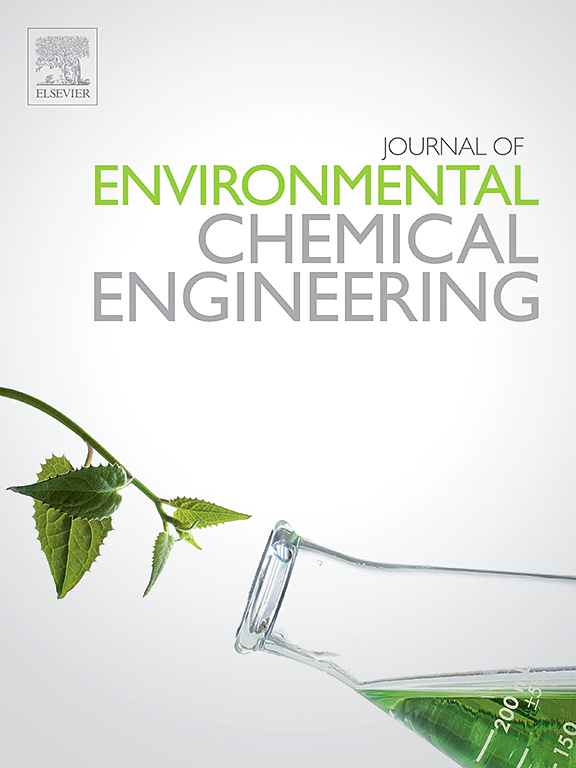微泡和纳米泡吸附去除全氟辛酸和全氟辛烷磺酸的机理研究综述
IF 7.4
2区 工程技术
Q1 ENGINEERING, CHEMICAL
引用次数: 0
摘要
全氟或多氟烷基物质(PFASs)因其在环境中的高浓度和严重的生态毒性而引起了人们的关注。独特的吸附特性支持其在全氟辛烷等污染物的修复中广泛应用。以往的研究主要集中在对吸附剂材料的探索与开发,对不同链长PFASs的去除效果进行评价,或对环境因素对PFASs去除的影响进行评价。然而,微泡(mb)或纳米泡(NBs)作为一种天然介质中常见但容易被忽视的物质,在PFASs吸附中的作用尚未得到系统的总结。因此,本文通过分析MBs/NBs在全氟辛烷(特别是PFOA和PFOS)吸附中的相关特性,介绍了它们在全氟辛烷吸附中的重要性。MBs/NBs能有效去除PFASs,在界面处富集,延长保留时间。系统分析了MBs/NBs参与下PFOS/PFOS吸附行为的分子动力学和吉布斯自由能理论计算。PFOS的疏水性大于PFOA,导致MBs对PFOS的吸附更强。环境因素主要影响MBs/NBs的稳定性和表面性能,以及PFOA/PFOS的疏水性,从而改变MBs/NBs对PFOA/PFOS的吸附行为。此外,总结了PFOA/PFOS在MBs/NBs上的吸附机理,静电和疏水相互作用主导了这种吸附行为。本文综述了全氟辛烷磺酸在水中的吸附研究进展。此外,它有助于更深入地评估MBs/NBs在吸附消除水生系统中PFASs的重要作用。本文章由计算机程序翻译,如有差异,请以英文原文为准。
Mechanistic insights into the adsorptive removal of PFOA and PFOS using microbubbles and nanobubbles: A review
Perfluoro- or polyfluoroalkyl substances (PFASs) have attracted research attention due to their high concentrations and severe ecotoxicity in the environment. The distinctive attributes of adsorption support its wide-scale application in the remediation of contaminants including PFASs. Previous studies mainly focused on the exploration and development of adsorbent materials, evaluating the removal of PFASs with different chain lengths, or assessing the impact of environmental factors on PFASs removal. However, the role of microbubbles (MBs) or nanobubbles (NBs), a commonly present but easily overlooked substance in natural media, in the PFASs adsorption has not been systematically summarized. Therefore, in this review, we introduce the importance of MBs/NBs in PFASs (particularly PFOA and PFOS) adsorption, by analyzing their characteristics related to adsorption. MBs/NBs can effectively remove PFASs by enriching at the interface and prolonging the retention time. The theoretical calculations of molecular dynamics and Gibbs free energy on the adsorption behavior of PFOS/PFOS with the participation of MBs/NBs were systematically analyzed. The hydrophobicity of PFOS, which is greater than that of PFOA, leads to stronger adsorption of PFOS by MBs. Environmental factors mainly affect the stability and surface properties of MBs/NBs, as well as the hydrophobicity of PFOA/PFOS, to alter the adsorption behavior of PFOA/PFOS mediated by MBs/NBs. Furthermore, the adsorption mechanisms of PFOA/PFOS on MBs/NBs were summarized, with electrostatic and hydrophobic interactions dominating this behavior. This review offers an enhanced and comprehensive insight into the adsorption of PFASs in water. Furthermore, it facilitates a more profound evaluation of the significant role played by MBs/NBs in the adsorptive elimination of PFASs from aquatic system.
求助全文
通过发布文献求助,成功后即可免费获取论文全文。
去求助
来源期刊

Journal of Environmental Chemical Engineering
Environmental Science-Pollution
CiteScore
11.40
自引率
6.50%
发文量
2017
审稿时长
27 days
期刊介绍:
The Journal of Environmental Chemical Engineering (JECE) serves as a platform for the dissemination of original and innovative research focusing on the advancement of environmentally-friendly, sustainable technologies. JECE emphasizes the transition towards a carbon-neutral circular economy and a self-sufficient bio-based economy. Topics covered include soil, water, wastewater, and air decontamination; pollution monitoring, prevention, and control; advanced analytics, sensors, impact and risk assessment methodologies in environmental chemical engineering; resource recovery (water, nutrients, materials, energy); industrial ecology; valorization of waste streams; waste management (including e-waste); climate-water-energy-food nexus; novel materials for environmental, chemical, and energy applications; sustainability and environmental safety; water digitalization, water data science, and machine learning; process integration and intensification; recent developments in green chemistry for synthesis, catalysis, and energy; and original research on contaminants of emerging concern, persistent chemicals, and priority substances, including microplastics, nanoplastics, nanomaterials, micropollutants, antimicrobial resistance genes, and emerging pathogens (viruses, bacteria, parasites) of environmental significance.
 求助内容:
求助内容: 应助结果提醒方式:
应助结果提醒方式:


